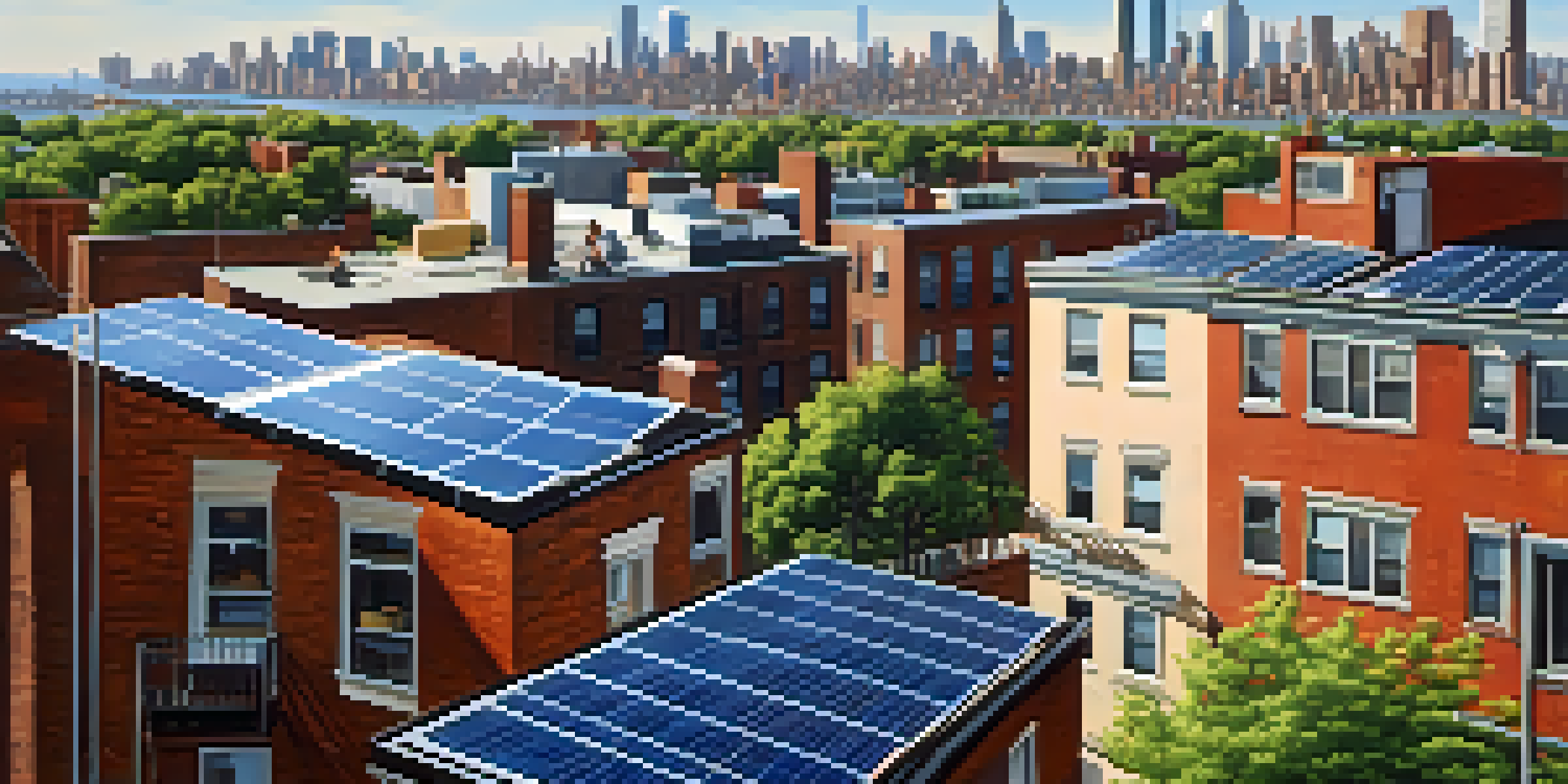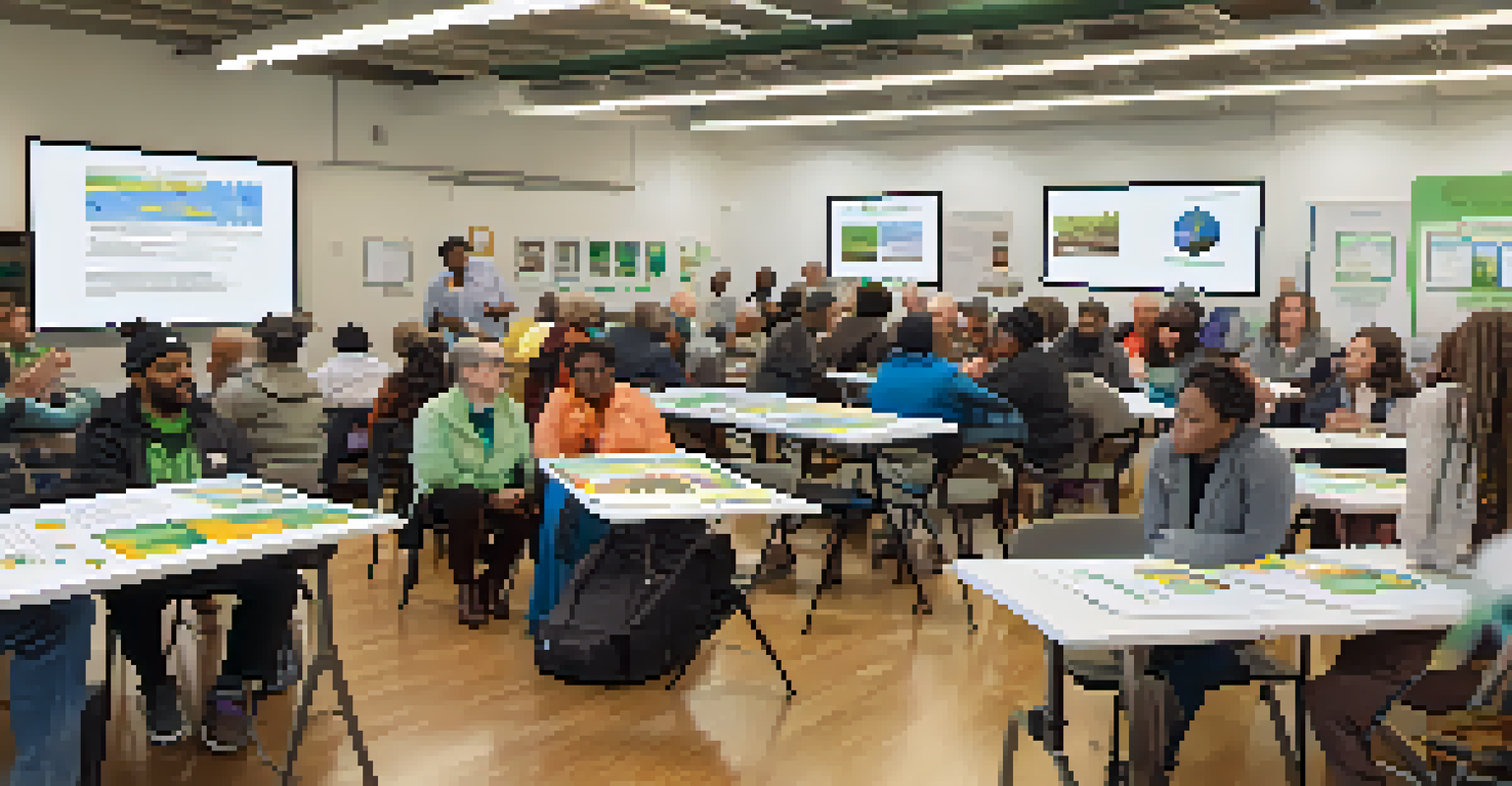Renewable Energy Projects: NYC's Shift Towards Sustainability

Overview of NYC's Commitment to Renewable Energy
New York City has made significant strides in committing to renewable energy. With ambitious goals set forth in the Climate Leadership and Community Protection Act, NYC aims to achieve 100% clean energy by 2040. This commitment reflects a broader trend in urban centers prioritizing sustainability and environmental stewardship.
The greatest threat to our planet is the belief that someone else will save it.
The city’s initiatives are not just about reducing carbon footprints; they also focus on improving public health and creating green jobs. For instance, NYC’s transition to renewable energy sources like solar and wind is expected to generate thousands of jobs in the green economy. This multifaceted approach illustrates a deep commitment to both the environment and its residents.
Additionally, NYC is actively engaging with communities to ensure that the benefits of renewable energy are equitably distributed. This means investing in neighborhoods that have historically been underserved and ensuring they have access to clean energy resources. Such efforts highlight the city's dedication to social equity as part of its sustainability plan.
Major Renewable Energy Projects in NYC
Among the notable projects is the New York City Solar Partnership, which aims to install solar panels on residential and commercial buildings across the city. This initiative not only boosts the use of renewable energy but also helps residents save on energy bills. Imagine turning your rooftop into a mini power plant that benefits both your wallet and the environment!

Another significant project is the offshore wind farm developments. These farms are expected to harness the powerful winds off the coast of New York, generating substantial clean energy. The first phase alone could power over 50,000 homes, showcasing how harnessing natural resources can lead to sustainable energy solutions.
NYC Aims for 100% Clean Energy by 2040
New York City is committed to achieving 100% clean energy by 2040, focusing on sustainability, public health, and job creation.
Moreover, NYC is investing in energy storage systems to support these renewable sources. This technology ensures that energy produced during sunny days or windy nights can be stored and utilized when demand peaks. It’s like having a battery for the city, ensuring a continuous supply of clean energy.
Community Involvement in Renewable Energy Initiatives
Community involvement is crucial in NYC's renewable energy strategy. Programs like the NYC Community Solar initiative allow residents, especially those in multifamily housing, to benefit from solar energy without needing to install panels directly. This democratizes access to renewable energy and ensures that more New Yorkers can participate in the green energy transition.
We do not inherit the earth from our ancestors; we borrow it from our children.
Engagement doesn’t stop there; NYC also hosts workshops and informational sessions to educate residents on energy efficiency and renewable solutions. By empowering individuals with knowledge, the city fosters a culture of sustainability. Think of it as a neighborhood potluck, where everyone brings something to the table to collectively create a healthier environment.
Furthermore, local organizations are stepping up to advocate for clean energy projects. Grassroots movements are critical in pushing for policies that prioritize sustainable initiatives and hold the city accountable. This sense of community activism illustrates that sustainability is a shared responsibility that can lead to significant change.
Challenges Facing NYC's Renewable Energy Transition
Despite the progress, NYC faces several challenges in its renewable energy transition. One major hurdle is the existing infrastructure, which was not built with renewable energy in mind. Upgrading this infrastructure to accommodate solar panels and wind turbines requires substantial investment and planning.
Additionally, there are regulatory and bureaucratic hurdles that can slow down project implementation. Navigating permits and compliance can be a complex process, often leading to delays that affect the timeline for achieving sustainability goals. It’s akin to trying to navigate through a maze, where every turn requires careful consideration and planning.
Community Engagement in Energy Access
Initiatives like the NYC Community Solar program empower residents, ensuring equitable access to renewable energy resources.
Lastly, public acceptance and awareness play a significant role. While many residents support renewable energy, some may be hesitant due to concerns about costs or changes in neighborhood aesthetics. Addressing these concerns through proactive communication and education is essential for fostering community support and ensuring successful project rollouts.
The Role of Technology in Renewable Energy
Technology is a game-changer in NYC's renewable energy landscape. Innovations in solar panel efficiency and wind turbine design allow the city to maximize energy production. For instance, recent advancements have made solar panels more effective, even in less-than-ideal weather conditions.
Moreover, smart grid technology is revolutionizing how energy is distributed throughout the city. By implementing real-time data and analytics, NYC can optimize energy usage and reduce waste, much like a conductor leading an orchestra to create a harmonious performance. This technology ensures that energy is delivered where it’s needed most, enhancing overall efficiency.
Energy storage solutions, such as advanced battery systems, are also critical. These technologies allow the city to store excess energy generated during peak production times, ensuring a steady supply even when production dips. It’s like saving up for a rainy day – a smart strategy for energy management.
Impact of Renewable Energy on NYC's Economy
The shift towards renewable energy is proving to be a boon for NYC's economy. As the city invests in sustainable projects, it simultaneously creates jobs in areas such as construction, engineering, and environmental science. These new opportunities are essential in a city where job growth is crucial for residents' livelihoods.
Additionally, the renewable energy sector is attracting investments from both public and private entities. As more companies recognize the importance of sustainability, NYC becomes a hub for innovation and green technology. This influx of investment not only supports job creation but also enhances the city’s reputation as a leader in sustainability.
Technological Innovations Drive Change
Advancements in technology, such as smart grids and energy storage, are crucial for maximizing efficiency and supporting NYC's renewable energy goals.
Furthermore, by transitioning to renewable energy, NYC can reduce its reliance on fossil fuels, leading to potential savings in energy costs. This shift not only benefits individual residents but also contributes to a more resilient economy in the long run. It’s a win-win scenario that aligns economic growth with environmental responsibility.
Looking Ahead: NYC's Future in Renewable Energy
As NYC forges ahead in its renewable energy journey, the future looks promising. The city has set ambitious goals, including a target of reaching 70% renewable energy by 2030. Achieving this goal will require continued innovation, community support, and strategic planning.
Moreover, collaborations with neighboring regions and states can amplify NYC's efforts. By forming partnerships to share resources and best practices, the city can enhance its renewable energy initiatives significantly. It’s much like a team sport, where collaboration leads to greater success.

Finally, public awareness and education will be crucial. As more residents understand the benefits of renewable energy, their support will help propel these initiatives forward. With a collective effort, NYC can truly become a model for other cities aiming for sustainability.